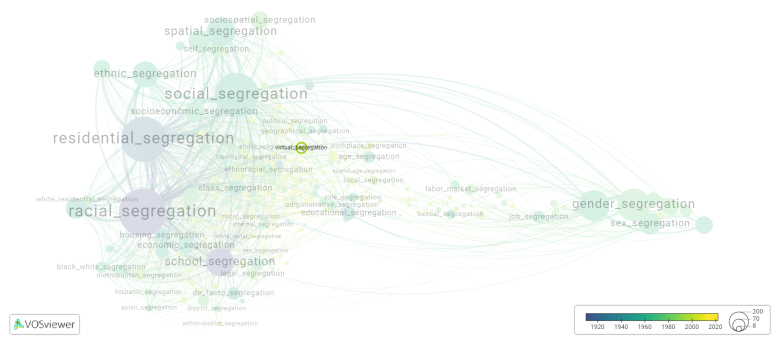Virtual segregation: Difference between revisions
(Creating page) |
(Creating page) |
||
| (2 intermediate revisions by the same user not shown) | |||
| Line 12: | Line 12: | ||
[[File:virtual_segregation.png|780x780px]] | [[File:virtual_segregation.png|780x780px]] | ||
This visualization is based on the study [[Segregation_Wiki:About| The Multidisciplinary Landscape of Segregation Research]]. | |||
For the complete network of | For the complete network of interrelated segregation forms, please refer to: | ||
* [https://tinyurl.com/2235lkhw First year of publication] | |||
* [https://tinyurl.com/2d8wg5n3 Louvain clusters] | |||
* [https://tinyurl.com/223udk5r Betweenness centrality] | |||
* [https://tinyurl.com/244d8unz Disciplines in which segregation forms first emerged (Scopus database).] | |||
==References== | ==References== | ||
==Notes== | ==Notes== | ||
Latest revision as of 07:17, 16 October 2024
Date and country of first publication[1][edit | edit source]
2006
United States
Definition[edit | edit source]
Virtual segregation refers to the division or separation of individuals or groups within online or digital spaces based on factors such as race, ethnicity, gender, or other social identities. This can occur through the creation of separate online communities, forums, or social media groups that cater to specific demographics or interests, leading to limited interactions and exchanges between different groups. Virtual segregation can perpetuate inequalities and reinforce social divisions in online environments. It is important to promote inclusivity and diversity in virtual spaces to ensure equal access and opportunities for all individuals.
See also[edit | edit source]
Related segregation forms[edit | edit source]
Virtual segregation is frequently discussed in the literature with the following segregation forms:
sociospatial segregation, spatial segregation

This visualization is based on the study The Multidisciplinary Landscape of Segregation Research.
For the complete network of interrelated segregation forms, please refer to:
References[edit | edit source]
Notes[edit | edit source]
- ↑ Date and country of first publication as informed by the Scopus database (December 2023).
At its current state, this definition has been generated by a Large Language Model (LLM) so far without review by an independent researcher or a member of the curating team of segregation experts that keep the Segregation Wiki online. While we strive for accuracy, we cannot guarantee its reliability, completeness and timeliness. Please use this content with caution and verify information as needed. Also, feel free to improve on the definition as you see fit, including the use of references and other informational resources. We value your input in enhancing the quality and accuracy of the definitions of segregation forms collectively offered in the Segregation Wiki ©.
Virtual segregation appears in the following literature[edit | edit source]
Kelley N. (2006). Virtual equality, virtual segregation. Society, 43(5), 15-21. https://doi.org/10.1007/BF02687567
Thiry-Cherques H. (201). Intranets: A semiological analysis. Journal of Information Science, 36(6), 705-718. https://doi.org/10.1177/0165551510381842
Li F., Wang D. (2014). Cyberspace: Connected or segregated? Examining virtual segregation among Hong Kong Internet users. Environment and Planning B: Planning and Design, 41(2), 323-340. Pion Limited.https://doi.org/10.1068/b39010
Dorman M., Svoray T., Kloog I. (202). How does socio economic and demographic dissimilarity determine physical and virtual segregation?. Journal of Spatial Information Science, 21(), 177-202. University of Maine.https://doi.org/10.5311/JOSIS.2020.21.587
